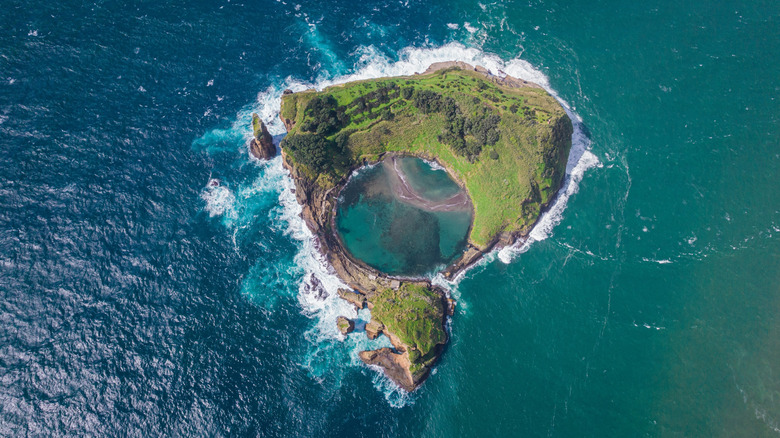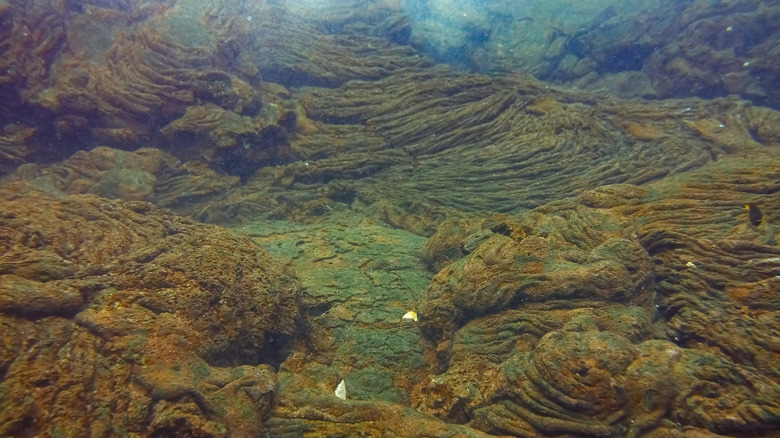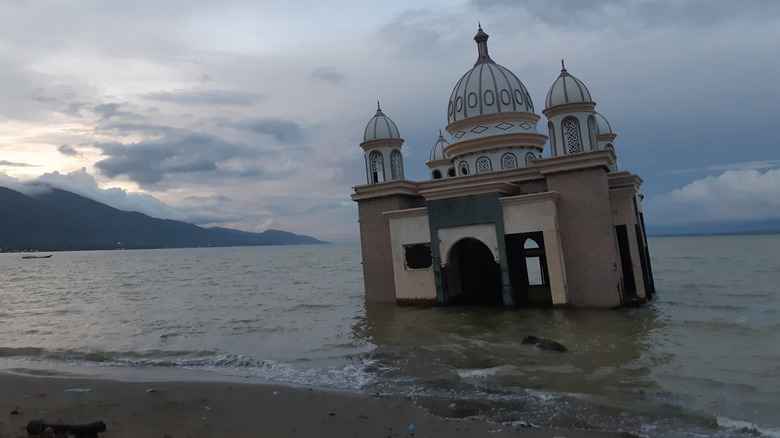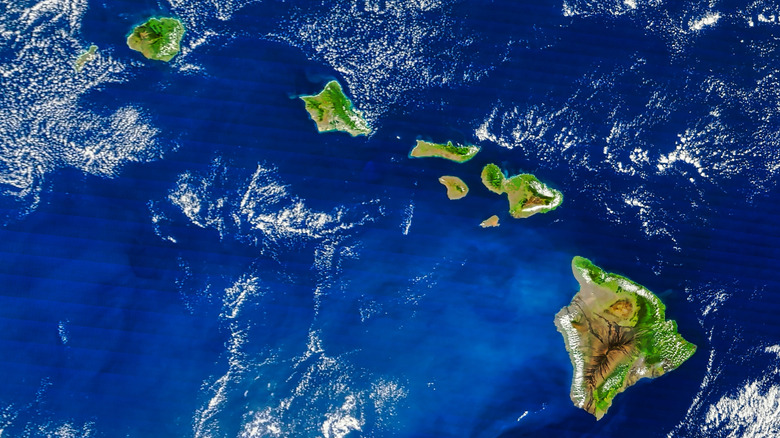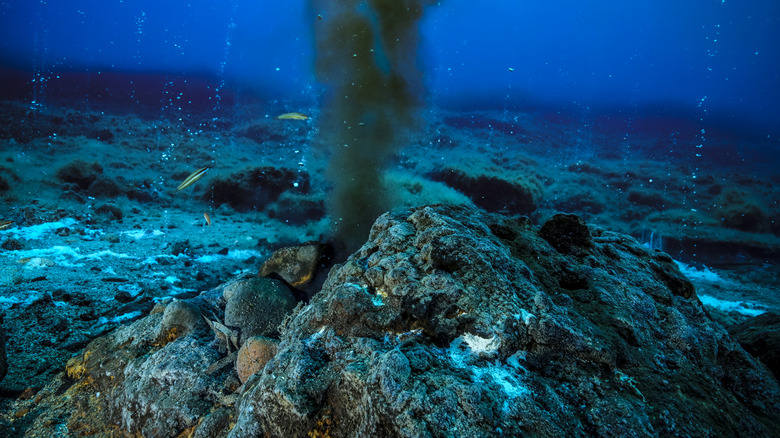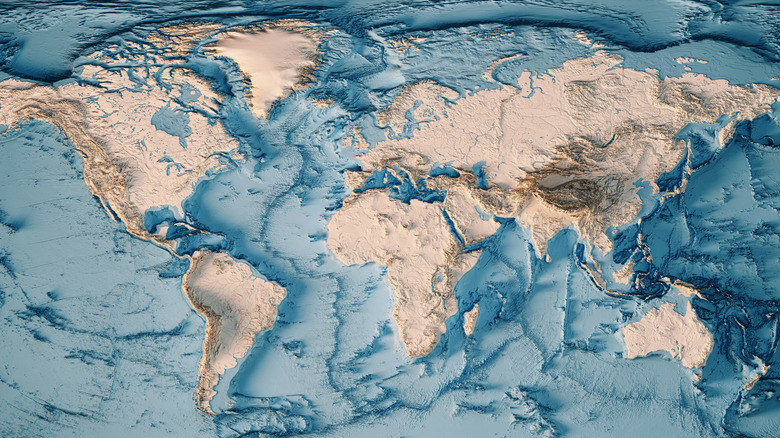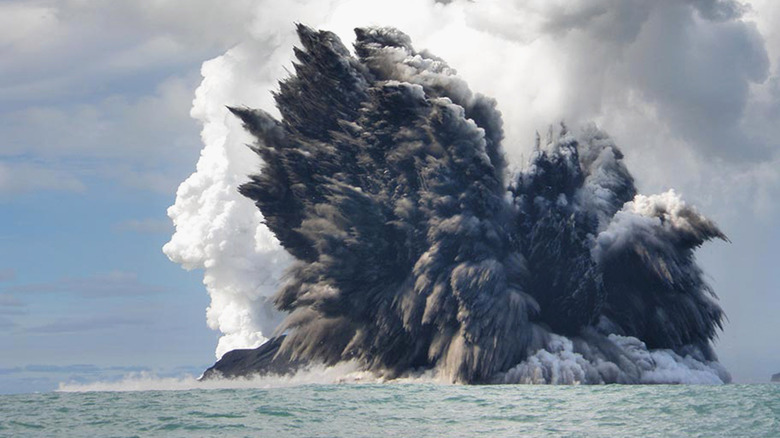What Happens When A Volcano Erupts Underwater?
Volcanic eruptions are perhaps nature's most terrifying display of power. Catastrophic eruptions of volcanoes like Mount Vesuvius, Krakatoa, and Mount St. Helens have gone down as some of the most notorious natural disasters in world history. Yet for all the times that humans have stared in horrified awe at the explosive force of a volcano, the vast majority of eruptions have gone completely unseen. That's because 80% of all volcanic eruptions actually take place below the surface of the ocean.
For most of human history, the workings of underwater volcanoes have been a mystery because the majority of them are located thousands of feet below sea level. However, with the technological advancements of the 21st century, scientists have now been able to map, measure, and even send cameras to record eruptions from the deepest volcanoes on the planet. We can now see exactly what happens when a volcano erupts undersea, and more importantly, how these eruptions make long-term changes to the environment
How water affects volcanic eruptions
A volcanic eruption occurs when magma, molten rock beneath the Earth's crust, breaks through a vent to the surface. That's true for any type of volcano, but eruptions look different under the ocean due to water pressure. Underwater volcanoes can experience more than 100 times the pressure of a volcano at sea level. All that pressure weighs upon the emerging magma, preventing it from exploding upwards like volcanic eruptions on land often do. Ocean water, especially thousands of feet below sea level, is extremely cold, and this causes any lava that erupts from an undersea volcano to solidify rapidly, so while there is still a degree of pyroclastic flow, it doesn't move at the rapid rate it could on land.
If the caldera of an underwater volcano is very close to the water's surface, it can send an eruption plume high into the sky. These plumes are formed when magma emerging from the volcano hits the surrounding water and vaporizes it, sending a blast of water vapor into the air, along with ash and rock fragments. Volcanoes can also erupt streams of hot water without disturbing the surface, creating a subtle, yet sinister threat. Around some particularly active volcanoes, the water can even be seen steaming like a cup of coffee between eruptions, a constant reminder of the power lurking just below the surface. These eruptions may not seem as violently destructive as those on land, but underwater volcanoes have their own way of dealing damage.
Underwater eruptions come with earthquakes and tsunamis
Underwater volcanoes don't rain destruction in the form of deadly ash and lava, but they are closely intertwined with other types of natural disasters, namely earthquakes and tsunamis, the effects of which can extend from sea to land. Volcanoes form from the movements of tectonic plates. Most of the world's volcanoes can be found along plate boundaries, especially in the Ring of Fire, a chain of over 450 volcanoes that encircles the Pacific Ocean.
Three-quarters of the volcanoes on Earth occur in this region, but it is also where about 90% of all the earthquakes in the world occur. It's no surprise that the two would go together, as earthquakes and volcanoes are closely interlinked. The movement of magma below the crust triggers earthquakes, which in turn trigger volcanic eruptions. In fact, scientists are often able to predict eruptions based on earthquakes, with some volcanic eruptions triggering tens of thousands of quakes. The quakes are often small, but some get extreme, like a pair of magnitude 5.9 and 6.0 earthquakes that occurred in Antarctica after a dormant volcano awoke in 2020.
Underwater eruptions and earthquakes are most dangerous to human civilization when they trigger tsunamis. In fact, a 2019 study published in the journal Scientific Reports found that tsunamis were responsible for 20% of all fatalities related to volcanic eruptions over the past 400 years. Fortunately, volcanic tsunamis are rare because they only occur if the erupting volcano is near to a coastline.
Many islands were born from underwater eruptions
Volcanic eruptions can deal terrifying destruction, but they can also create incredible things, like new landmasses. Hundreds of islands all around the world were born from the eruptions of underwater volcanoes, including the islands of Hawaii and Samoa in the central Pacific Ocean, and the island of Iceland in the north Atlantic Ocean. Without the forces of underwater volcanoes, the generations that have called these islands home, and the unique cultures that grew as a product of those environments, wouldn't exist as we know them.
Island formation typically begins when an underwater volcano starts passively flowing lava. The pressure of the water causes the lava to spread outward, and the frigid temperatures of the ocean depths rapidly cool it. When lava cools, it forms rock, and over millions of years, enough rock builds up that it pushes the volcano upwards. Eventually, it gets close enough to the surface that water pressure can no longer suppress an eruption, and at that point, things get violent.
If an underwater volcano erupts very close to the ocean's surface, it can spew material out of the water and begin forming a landmass. Lava flows, rocks, and volcanic ash produced by continued eruptions add to that landmass, growing the island over the course of millions of years. However, without continued long-term volcanic activity, these islands can erode until the mass vanishes under the water again.
How underwater volcanoes affect marine life
Volcanoes both kill and nurture. On land, eruptions spew lava and ash, which enrich the surrounding soil, fostering future life. Underwater volcanoes wield the same combination of destructive and creative capacity, although naturally, the circumstances are a little bit different. When underwater volcanoes erupt, the high heat and lava they emit will kill fish and other marine life that are unfortunate enough to be in the way. However, in the time between eruptions, these environments are surprisingly rich with life.
Just as volcanic emissions enrich the oil on land, the mineral-rich gasses that bubble out of cracks in undersea volcanoes nurture a wealth of life. Not just any species can handle these extreme environments, though. It takes special adaptations, like the ability to endure extremely acidic water conditions caused by the carbon dioxide and sulfur leaking from within the earth. Against the odds, some sharks have mutated to survive in underwater volcanoes, as have many small fish and crustaceans.
Underwater volcanoes open cracks in the seafloor known as hydrothermal vents, which, despite causing extremely hot and acidic water conditions, have been found to be teeming with life. Located deep beneath the water along volcanic arcs like the East Pacific Rise, hydrothermal vents are home to lifeforms that don't appear anywhere else on Earth, including some of the most ancient microbes ever discovered. Some scientists have even proposed that hydrothermal vents opened by underwater volcanoes could have been the origin point of all life on Earth.
How scientists study underwater volcanoes
Studying underwater volcanoes has historically been immensely challenging due to the fact that most of them are thousands of feet below the surface, shrouded in dark, frigid waters. However, technology has finally caught up to the point that we are now able to identify and map hundreds of volcanoes with accuracy, and even record footage of them in action.
In order to observe an underwater volcano, you first have to locate one, and scientists use a few different tools for this task. Oftentimes, the first clues are found in seismic activity, which scientists can record using seismometers placed on the ocean floor. When they find hotspots of seismic activity, there's a good chance a volcano could be lying under the water. To locate and map a volcano, a bottom pressure recorder, is often used. This instrument measures water pressure, and because pressure changes according to the water's depth, it can reveal mounts that rise from the rest of the sea floor.
A particularly thrilling breakthrough in volcanology came in 2009, when, for the very first time, a team of scientists recorded video footage of an underwater eruption. Recorded at the West Mata volcano, located in the South Pacific between Samoa and Tonga, the video shows the unique action of eruptions underwater, as lava emerges like giant fiery bubbles. Hopefully, more footage of eruptions will come in the future, but perhaps more interestingly, footage of how life returns to eruption sites could follow.
Recent examples of underwater volcanic eruptions
Since underwater volcanic eruptions rarely cause any harm to humans, you might not realize how many of them have happened just in this decade. 2022 saw the most powerful underwater eruption ever recorded at the Hunga Tonga–Hunga Ha'apai volcano in the South Pacific. More powerful than any atomic bomb test, it was heard by people as far away as Alaska, a distance of over 6,000 miles. The tip of the volcano was slightly above the waterline, and as a result, the eruption shot a plume of vapor that contained enough water to fill 58,000 Olympic swimming pools, and caused a temporary drop in ozone in the atmosphere.
In 2023, scientists got to see another facet of underwater volcanism on display when a new island began to form off the coast of Iwo Jima island in Japan. It was created when an unnamed volcano erupted over the course of 10 days, ultimately ejecting enough material to breach the surface and begin forming an island. However, by mid-2024, the tiny land mass had been mostly submerged again, illustrating the fragility of new volcanic islands.
As of the writing of this article, volcanic eruptions are anticipated in several U.S. states, including at the Axial Seamount, an underwater volcano off the coast of Oregon. Fortunately for residents of the Pacific Northwest, this volcano is hundreds of miles from the coast and almost a mile below the water, so it probably won't have any effect on human civilization.
